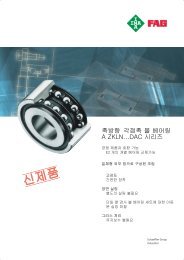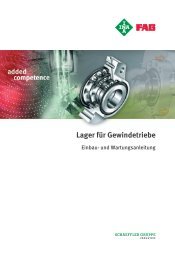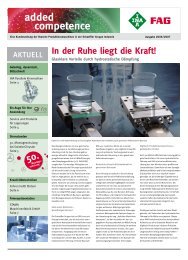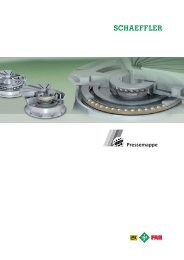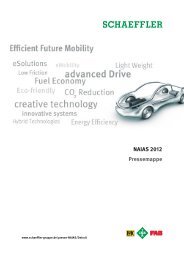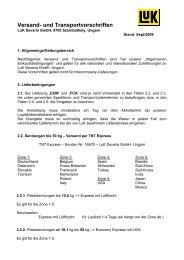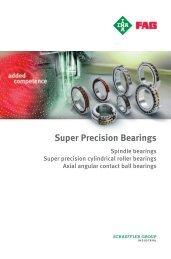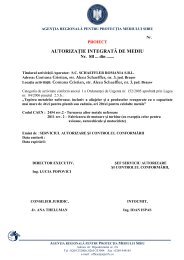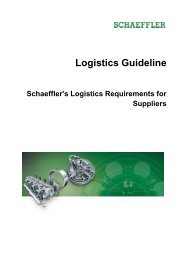Double clutch
Double clutch
Double clutch
You also want an ePaper? Increase the reach of your titles
YUMPU automatically turns print PDFs into web optimized ePapers that Google loves.
9 <strong>Double</strong> <strong>clutch</strong><br />
through an oil cooler before it is provided to the<br />
<strong>clutch</strong> as a cooled agent.<br />
With the suction control valve in the “cool” position,<br />
the volume flow is determined by the theoretical<br />
displacement rate of the pump. In this<br />
state, adequate oil flows through the oil cooler<br />
maintains the thermal equilibrium of the complete<br />
transmission during “hill holding” and<br />
“uphill creeping”.<br />
In the “drive” position, the oil volume flow can<br />
be greatly reduced. It only prevents burning of<br />
the open <strong>clutch</strong> linings and ensures cooling of<br />
the actuated <strong>clutch</strong> under microslippage control.<br />
In this operating condition approx. 2…3 l/min of<br />
oil flow through the oil cooler. This oil quantity<br />
gives sufficient cooling for the small additional<br />
pump losses which compares to a manual<br />
gearshift of approx. 1 kW during rapid travel and<br />
hence maintains a stable thermal equilibrium in<br />
the complete transmission.<br />
Since the pump is used only for cooling and<br />
lubrication of the <strong>clutch</strong> and only pressure<br />
losses in the oil cooler and ducts must be<br />
considered, pump pressures significantly<br />
below 1 bar occur in the range relevant to consumption<br />
and maximum pressures below<br />
5 bar during <strong>clutch</strong> cooling and low oil temperatures.<br />
These low pressures allow a technological leap<br />
in selecting the material for the pump, which<br />
can now be made almost entirely of plastic.<br />
The suction control valve can simply be integrated<br />
in the pump housing. Due to the use<br />
of plastic, no machining of parts is required<br />
and a significant cost benefit can be achieved<br />
(figure 15).<br />
The combination of a lever-actuated double<br />
wet <strong>clutch</strong> and a simple, robust cooling concept<br />
significantly reduces the complexity of<br />
the wet <strong>clutch</strong> without compromises on functionality.<br />
LuK is also working on cooling concepts using<br />
a ring-shaped oil cooler and the kinetic energy<br />
of the rotating oil emerging from the <strong>clutch</strong> to<br />
create coolant oil circulation (figure 16). A jet<br />
pump ensures permanent exchange between<br />
the circulating oil and the oil sump. This also<br />
allows complete utilisation of the oil sump as a<br />
heat sink in situations with high energy inputs.<br />
Figure 15 Plastic pump<br />
These measures allow simplified feed layout,<br />
use of a more economical cooler and even<br />
elimination of the already economical plastic<br />
pump.<br />
Fuel consumption<br />
One of the most important issues in the development<br />
of double <strong>clutch</strong> transmissions is utilisation<br />
of the high transmission efficiency and the<br />
associated favourable fuel consumption of the<br />
vehicle.<br />
If one analyses the fuel consumption data provided<br />
by automotive manufacturers, it is apparent<br />
that the high efficiency of the mechanical<br />
transmission side does not automatically give<br />
low consumption over the cycle (figure 17). In<br />
diesel vehicles with low and moderate power ratings<br />
in particular, the double <strong>clutch</strong> transmission<br />
still cannot use its advantages. Even the<br />
CVT transmissions, which are little disadvantaged<br />
in the partial load range in relation to variator<br />
efficiency, give some better or comparable<br />
results. At present the double <strong>clutch</strong> transmission<br />
is only convincing at high powered gas<br />
engines.<br />
Why is this the case? The CVT transmission<br />
development engineers have compensated<br />
the small disadvantages at variator side by<br />
application of dual flow pumps and jet pumps<br />
as well as a hydraulic concept optimised in<br />
terms of low operating pressures and pump<br />
size.<br />
130 LuK SYMPOSIUM 2006



